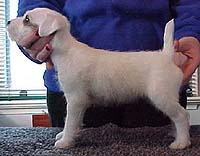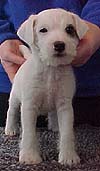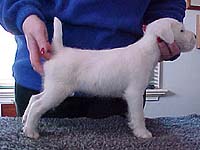Presenting Terriers
for Prospective Buyers
How Information Can Help the Future of our Breed
Presenting a dog or a puppy for prospective homes or for stud can be done well with great benefit to your kennel. Reputable breeders will exchange information readily and with candor with the goal of improving the breed's genetic health.
A breeder will readily provide the prospective buyer with information about the terrier and its genetic background:
- Temperament Description or Video
- Allow the prospective buyer to see and visit with the dam and perhaps the sire
- Information about any known genetic faults in the dog's lines
- The owners and contact information for the grandparents, if living
Photographing the Terrier
Photographing dogs for the prospective buyer is much like photographing adult dogs for registration. The breeder should provide the prospective buyer with at least three views of the terrier at the pup's eye level: right side, left side and front view at eight weeks old or older. I also like to include a close up of the pups head to show their expression. It is helpful to have a contrasting background to make the terrier stand out. Also, make sure that the photo is in focus and that the camera is the same distance in each photo.
The educated buyer will be looking at the terrier's conformation including angulation, topline, head, ears, chest, coloration and for characteristics to compliment their lines. Know the breed standard and the requirements for registration photographs before you take photos and it will help you save time and money.
Temperament
Temperament is one of the most important citerion for the buyer. The buyer may be interested in lines that have one nature over another and the breeder may want to provide the buyer with a video of the terrier. Video is also very helpful for the buyer. Video may be added as supplemental information about a terrier's interaction and temperament in play with other dogs and people.The Pedigree
The prospective buyer should be informed about genetics and the genetic make up of the terrier that is being presented to them. A 4 to 5 generation pedigree should be provided with details including birthdate, registration numbers, owner, breeder, color, height and coat on each ancestor, if available. If a buyer is trying to achieve a certain look or to breed with their lines, they will need to know what is behind the terrier. Pedigree software is on the market for a small investment you can provide a pedigree that can be mailed, faxed or emailed or even posted on your web page. Photos on the pedigree of the ancestors can provide more information for the buyer.
PEDIGREE
Terrier
Birthdate:_______
Registration # (if any)
Height, Color Coat
Parents GrandParents Great GrandParents
Father
Reg #Birthdate
Height, Color, Coat
Owner
BreederCERF results
BAER results
Paternal Grandfather
Reg #
BirthdateHeight, Color, Coat
Owner
BreederCERF results
BAER resultsGreat Grandfather
Reg #
Height, Color, CoatGreat Grandmother
Reg #
Height, Color, Coat
Paternal Grandmother
Reg #
BirthdateHeight, Color, Coat
Owner
BreederCERF results
BAER resultsGreat Grandfather
Reg #
Height, Color, CoatGreat Grandmother
Reg #
Height, Color, Coat
Mother
Reg #Birthdate
Height, Color, Coat
Owner
BreederCERF results
BAER resultsMaternal Grandfather
Reg #
BirthdateHeight, Color, Coat
Owner
BreederCERF results
BAER results
Great Grandfather
Reg #
Height, Color, CoatGreat Grandmother
Reg #
Height, Color, Coat
Paternal Grandmother
Reg #
BirthdateHeight, Color, Coat
Owner
BreederCERF results
BAER results
Great Grandfather
Reg #
Height, Color, CoatGreat Grandmother
Reg #
Height, Color, Coat
An educated breeder would know that each terrier and each mating must be viewed separately and on its own merits. Since all living beings have genetic strengths and weaknesses, it is only in combination that a breed's future can be determined. The buyer who is embarking on a breeding program should understand that the genetic information on a dog can be incomplete without considering the terrier(s) that the dog will be bred to. For instance, if your terrier has is a carrier for a geentic fault you might decide to breed it to a terrier that does not have that same fault in its pedigree. This mating may provide superior results and a better future for the breed. An affected dog should never be bred, however in a breed where there are few clean lines, you may be able to intelligently reduce the risk to the breed by breeding away from the trait. By breedng dogs that have a lower risk than the average dog in the gene pool you can decrease the average risk of having an affected dog over time. You can read more about these concepts by purchasing Dr. George Padget's book on Canine Genetics or by looking into the Jack Russell Terrier Genetic Study that is being done by the UC Davis Veterinary School.
BAER & CERF Testing & Certification
A breeder should include the terriers microchip number on the paperwork at the time of the BAER & CERF tests for positive identification.BAER ( Brainstem Auditory Evoked Response) testing for each terrier can be done at an early age and will help to avoid hearing problems in future terriers. A BAER test & graph that shows hearing activity for the terrier is sufficient to show the buyer with positive identification for the specific dog that was tested.
A CERF (Canine Eye Registration Foundation) is an annual test starting at one year old. Having the CERF test on the terrier, it's parents and grandparents should provide the buyer with a fairly good picture of the line's current eye health. The responsible breeder will have obtained copies of the CERF & BAER paperwork for the stud and the bitch prior to breeding. The reason for including both parents and grandparents is to see how the bloodline's eyes will fare with age. A breeder can certify their terriers with the CERF Foundation. The information on a particluar terrier may be available to buyers on the CERF website if the dog is certified. If a dog is not registered it will not have a certificate however it may still be clear for that year.
Providing the buyer with a current and complete package of information will do much to improve and maintain your image as a breeder. A buyer may easily be discouraged by having to ask for information more than once. If you cannot provide the information right away, notify the buyer that you will provide it by a certain date.
Once a buyer makes a decision to buy or not to buy they will notify you. The breeder will want to take a no-buy decision in stride and keep the communication channels open. Thanking the buyer and the person who made the referal for considering your lines as it may win you referals to other buyers and it may bring the buyer back to view your kennel another day.
The ethical breeder will provide as full disclosure to the prospective buyer as they are able to. The buyer will know that if little or no information is provided by the breeder, their potential risk can be much higher. The educated buyer will prefer a candid, open conversation with a breeder. You can help them understand that perfect information is only available in a perfect world, but you have provided your best effort to help them make educated decisions. Using information, education and appropriate breeding we can all work to improve our breed's genetic future.


